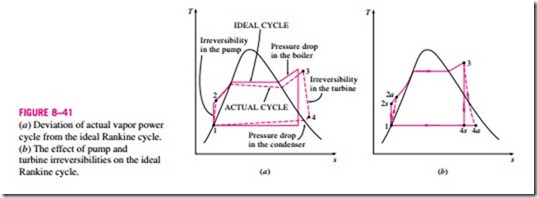DEVIATION OF ACTUAL VAPOR POWER CYCLES FROM IDEALIZED ONES
The actual vapor power cycle differs from the ideal Rankine cycle, as illustrated in Fig. 8–41a, as a result of irreversibilities in various components. Fluid friction and heat loss to the surroundings are the two common sources of irreversibilities.
Fluid friction causes pressure drops in the boiler, the condenser, and the piping between various components. As a result, steam leaves the boiler at a somewhat lower pressure. Also, the pressure at the turbine inlet is somewhat lower than that at the boiler exit due to the pressure drop in the connecting pipes. The pressure drop in the condenser is usually very small. To compensate for these pressure drops, the water must be pumped to a sufficiently higher pressure than the ideal cycle calls for. This requires a larger pump and larger work input to the pump.
The other major source of irreversibility is the heat loss from the steam to the surroundings as the steam flows through various components. To maintain the same level of net work output, more heat needs to be transferred to the steam in the boiler to compensate for these undesired heat losses. As a result, cycle efficiency decreases.
Of particular importance are the irreversibilities occurring within the pump and the turbine. A pump requires a greater work input, and a turbine produces a smaller work output as a result of irreversibilities. Under ideal conditions, the flow through these devices is isentropic. The deviation of actual pumps and turbines from the isentropic ones can be accurately accounted for, how- ever, by utilizing isentropic efficiencies, defined as
where states 2a and 4a are the actual exit states of the pump and the turbine, respectively, and 2s and 4s are the corresponding states for the isentropic case (Fig. 8–41b).
Other factors also need to be considered in the analysis of actual vapor power cycles. In actual condensers, for example, the liquid is usually sub- cooled to prevent the onset of cavitation, the rapid vaporization and condensation of the fluid at the low-pressure side of the pump impeller, which may damage it. Additional losses occur at the bearings between the moving parts as a result of friction. Steam that leaks out during the cycle and air that leaks into the condenser represent two other sources of loss. Finally, the power consumed by the auxiliary equipment such as fans that supply air to the furnace should also be considered in evaluating the performance of actual power plants.
The effect of irreversibilities on the thermal efficiency of a steam power cycle is illustrated next with an example.



